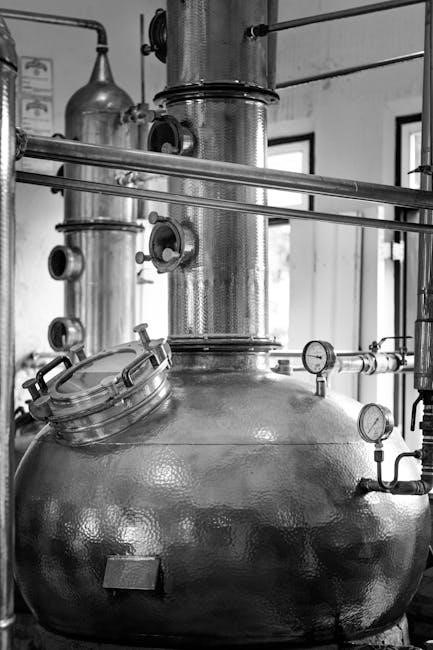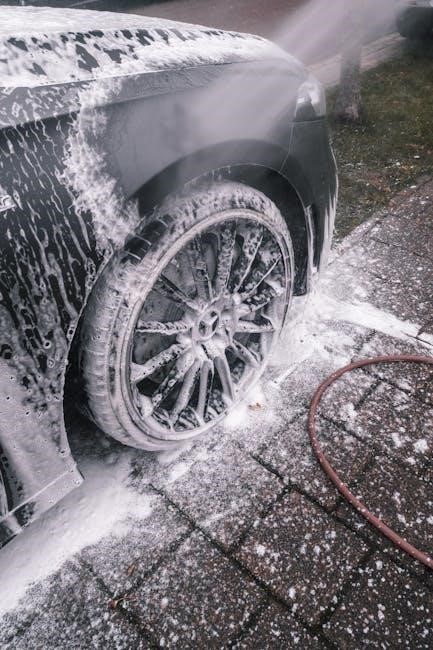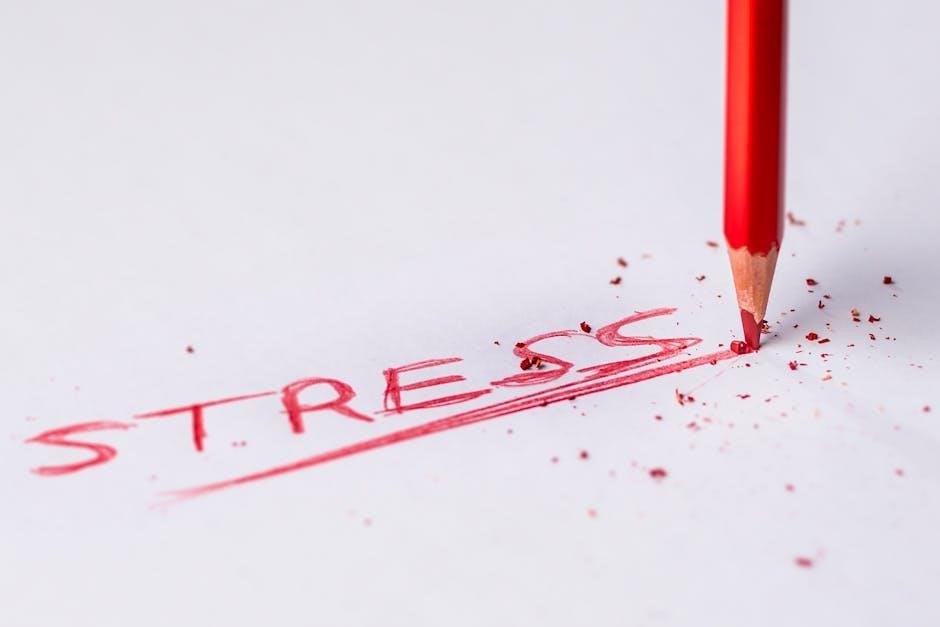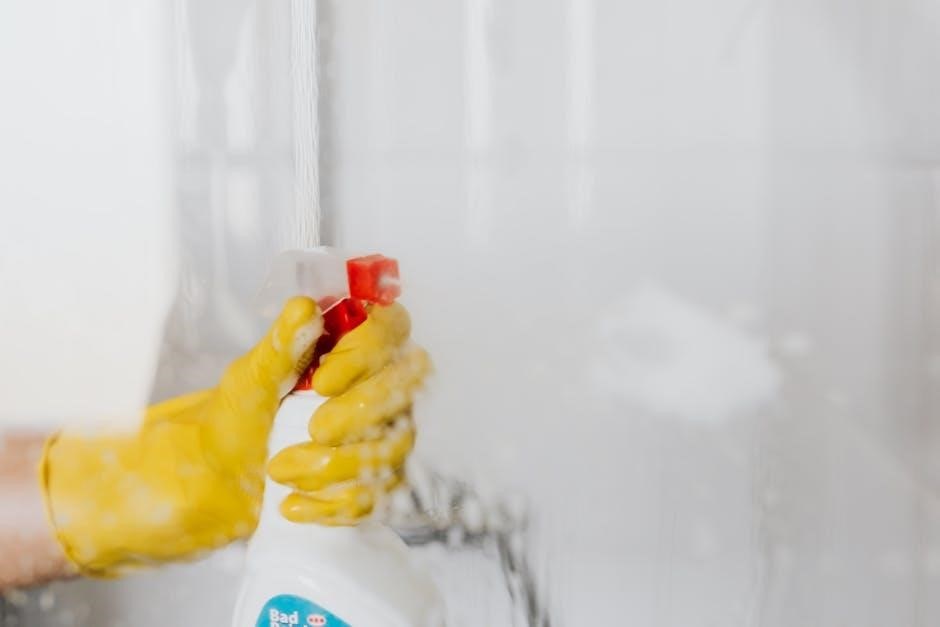pressure washer nozzle chart pdf

Pressure washer nozzle charts are essential tools for matching your washer’s PSI and GPM to the correct nozzle size‚ ensuring optimal cleaning efficiency and surface safety․
1․1 Understanding the Importance of Nozzle Selection
Selecting the right nozzle for your pressure washer is crucial for achieving optimal cleaning results while protecting surfaces from damage․ Using the wrong nozzle can lead to inefficient cleaning‚ surface damage‚ or even equipment wear․ Nozzle charts provide a guide to match your washer’s PSI and GPM to the appropriate nozzle size‚ ensuring safety and effectiveness․ Proper selection enhances cleaning efficiency‚ prevents damage‚ and extends the lifespan of your pressure washer․ By understanding nozzle types and their applications‚ you can make informed decisions for various cleaning tasks․
1․2 Overview of Pressure Washer Nozzle Types
Pressure washer nozzles come in various types‚ each designed for specific cleaning tasks․ Standard nozzles offer different spray angles‚ ranging from narrow to wide fans‚ catering to tasks from heavy-duty cleaning to delicate surfaces․ Specialized nozzles‚ like turbo and rotary options‚ provide intense cleaning power for tough grime․ Additionally‚ interchangeable nozzles allow versatility‚ adapting to different jobs․ Nozzle charts help identify the best type for your needs‚ ensuring efficient and safe cleaning․ Understanding these options enables you to choose the right tool for any surface‚ enhancing your cleaning effectiveness and protecting your equipment․

Basics of Pressure Washer Nozzles
Pressure washer nozzles control water flow and pressure‚ directing it into a focused spray․ They are sized based on GPM and PSI‚ with charts providing essential guidance for optimal performance․
2․1 What Are Pressure Washer Nozzles?
Pressure washer nozzles are interchangeable attachments that alter the water flow pattern and intensity․ They are designed to compress water into a focused spray‚ enhancing cleaning efficiency․ Available in various sizes and types‚ nozzles determine the spray angle and pressure‚ making them crucial for different cleaning tasks․ Nozzles are typically color-coded for easy identification and sized according to the washer’s PSI and GPM․ Proper nozzle selection ensures effective cleaning without damaging surfaces․ Using a nozzle chart helps match the right nozzle to your pressure washer’s specifications for optimal performance․
2․2 How Nozzles Affect Cleaning Efficiency
Pressure washer nozzles significantly influence cleaning efficiency by determining water flow pattern‚ pressure‚ and spray angle․ Different nozzles create varying spray widths and intensities‚ tailored for specific tasks․ A narrower spray angle increases pressure intensity‚ making it ideal for tough stains‚ while wider angles provide gentler cleaning for delicate surfaces․ Using the wrong nozzle size can compromise cleaning power or damage surfaces․ Proper nozzle selection‚ guided by a nozzle chart‚ ensures optimal performance‚ balancing cleaning effectiveness with surface safety․ This makes nozzles indispensable for achieving desired results across various cleaning applications․
2․3 Common Nozzle Sizes and Spray Patterns
Pressure washer nozzles come in standard sizes‚ often denoted by their spray angles‚ such as 15°‚ 25°‚ 40°‚ and 65°․ Each size delivers a specific water flow pattern‚ with narrower angles providing higher pressure for heavy-duty cleaning and wider angles offering lower pressure for delicate surfaces․ Spray patterns range from focused jets to wide fans‚ tailored for tasks like stripping paint or rinsing surfaces․ Nozzle size charts help users match their washer’s PSI and GPM to the optimal nozzle‚ ensuring efficient cleaning without damaging surfaces․ Proper selection enhances performance and safety across various cleaning applications․

Pressure Washer Nozzle Color Coding
Nozzle color coding simplifies selection‚ with each color representing specific spray angles and pressure levels․ This system ensures users choose the right nozzle for their cleaning task efficiently․
3․1 What Do Different Nozzle Colors Mean?
Different nozzle colors indicate varying spray angles and pressure levels․ For example‚ a white nozzle offers a wide 40-degree spray for gentle cleaning‚ while a red nozzle delivers a narrow 0-degree jet for intense cleaning․ Each color corresponds to a specific spray pattern‚ ensuring users can quickly identify the right nozzle for their task․ This color-coded system enhances safety and efficiency‚ preventing potential damage to surfaces․ By matching the color to the job‚ users can achieve optimal cleaning results without trial and error․
3․2 Matching Nozzle Colors to Cleaning Tasks
Matching nozzle colors to cleaning tasks ensures effective and safe results․ White nozzles (40°) are ideal for delicate surfaces like windows‚ while green nozzles (25°) suit general cleaning․ Yellow nozzles (15°) handle heavy-duty tasks‚ and red nozzles (0°) are for extreme cleaning․ Each color corresponds to a specific spray angle and pressure level‚ making it easier to select the right nozzle for the job․ Always start with the gentlest option to avoid surface damage and adjust as needed for optimal performance and safety․
Nozzle Size Selection Chart
A nozzle size chart helps determine the optimal orifice size based on your pressure washer’s PSI and GPM‚ ensuring proper water flow and pressure balance․
4․1 How to Determine the Right Nozzle Size
To determine the right nozzle size‚ start by identifying your pressure washer’s PSI and GPM ratings․ Use a nozzle size chart to find the optimal orifice size that matches these specifications․ Ensure the nozzle size is not too small‚ as it can cause equipment damage‚ or too large‚ which may reduce cleaning effectiveness․ Refer to the chart’s conversion table to adapt measurements if necessary․ Proper nozzle sizing ensures efficient water flow and maintains the pressure washer’s performance․ Always consult the manufacturer’s guidelines for precise recommendations․
4․2 Using PSI and GPM to Choose the Correct Nozzle
To select the correct nozzle‚ consider your pressure washer’s PSI and GPM ratings․ PSI determines the pressure intensity‚ while GPM affects the water flow rate․ Use a nozzle chart to match these values with the appropriate orifice size․ For example‚ a washer with 3000 PSI and 4․0 GPM requires a specific nozzle size to maintain efficiency․ Always refer to the chart to avoid oversized or undersized nozzles‚ which can compromise performance or damage equipment․ Proper alignment ensures optimal cleaning power and protects your pressure washer from potential wear․
4․3 Nozzle Size Chart Explanation
A nozzle size chart is a comprehensive guide that maps pressure washer specifications to the ideal nozzle orifice size․ It typically lists PSI‚ GPM‚ and corresponding nozzle sizes‚ ensuring proper compatibility․ The chart helps users avoid using nozzles that are too small‚ which can overpressure the system‚ or too large‚ which reduces cleaning effectiveness․ By aligning your washer’s PSI and GPM with the chart‚ you can determine the correct nozzle size for optimal performance․ This tool is essential for maintaining efficiency‚ preventing equipment damage‚ and achieving the best cleaning results for various tasks․

Spray Patterns and Angles
Pressure washer nozzles create various spray patterns‚ from wide fan sprays for delicate surfaces to narrow‚ concentrated jets for heavy-duty cleaning․ The chart helps determine the optimal angle for specific tasks‚ ensuring efficient cleaning while preventing surface damage․
5․1 Understanding Spray Pattern Degrees
Understanding spray pattern degrees is crucial for effective cleaning․ Nozzles are categorized by their spray angles‚ ranging from narrow (0°-15°) for intense cleaning to wide (40°-65°) for gentle rinsing․ Narrow angles‚ like 0°‚ deliver concentrated power‚ ideal for tough stains or heavy-duty tasks․ Wider angles‚ such as 40°‚ provide a broader coverage‚ making them suitable for delicate surfaces like siding or windows․ Referencing a pressure washer nozzle chart PDF helps match the correct spray angle to the task‚ ensuring optimal results without damaging surfaces․ This guide simplifies the selection process‚ enhancing both efficiency and safety․
5․2 Choosing the Right Spray Angle for the Job
Selecting the correct spray angle ensures efficient cleaning without damaging surfaces․ Narrow angles (0°-15°) are ideal for heavy-duty tasks like removing stubborn stains or cleaning concrete․ Medium angles (25°-35°) balance power and coverage‚ suitable for general cleaning․ Wider angles (40°-65°) are gentle‚ perfect for delicate surfaces like siding or cars․ Always consult a pressure washer nozzle chart PDF to match the angle to your task․ Proper selection enhances cleaning effectiveness and prevents surface damage‚ making your pressure washer more versatile and safer to use for various applications․

Pressure Washer Nozzle Materials
Pressure washer nozzles are made from materials like brass‚ stainless steel‚ plastic‚ or ceramic․ Brass and stainless steel are durable for high-pressure use‚ while plastic and ceramic suit lighter tasks․
6․1 Types of Nozzle Materials
Pressure washer nozzles are crafted from various materials‚ each offering unique benefits․ Brass and stainless steel nozzles are robust and ideal for high-pressure applications‚ ensuring durability and resistance to wear․ Plastic nozzles are cost-effective and suitable for lighter tasks‚ while ceramic nozzles are gentle on surfaces and prevent scratching․ Each material is tailored to specific cleaning needs‚ balancing performance‚ longevity‚ and cost․ Understanding these options helps users select the right nozzle for their pressure washer‚ optimizing efficiency and surface protection․ Proper material choice extends equipment lifespan and enhances cleaning results․
6․2 Durability and Performance of Different Materials
Different materials significantly impact nozzle durability and performance․ Brass and stainless steel nozzles excel in high-pressure environments‚ offering exceptional resistance to corrosion and wear․ Plastic nozzles‚ while less durable‚ are lightweight and affordable‚ making them ideal for casual use․ Ceramic nozzles provide superior abrasion resistance and are perfect for delicate surfaces․ Each material’s performance is tailored to specific tasks‚ ensuring optimal cleaning results․ By selecting the right material‚ users can enhance their pressure washer’s efficiency and extend nozzle lifespan‚ achieving better outcomes across various cleaning applications․

Nozzle Maintenance and Care
Proper maintenance ensures optimal performance․ Regularly clean nozzles to prevent clogs and store them in dry‚ protected areas․ This extends lifespan and maintains efficiency․
7․1 Tips for Extending Nozzle Lifespan
Regular maintenance is key to extending the life of your pressure washer nozzles․ Clean nozzles after each use to remove dirt and debris‚ ensuring proper water flow․ Store them in a dry‚ protected area to prevent rust or corrosion․ Avoid using harsh chemicals or abrasive cleaners‚ as they can damage the material․ Inspect nozzles regularly for wear and tear‚ replacing them when necessary․ Proper storage and care can significantly extend the lifespan of your nozzles‚ ensuring optimal performance and efficiency in future cleaning tasks․
- Clean nozzles after each use to prevent clogs․
- Store in a dry‚ cool place to avoid rust․
- Avoid harsh chemicals that may damage materials․
- Inspect for wear and tear regularly․
7․2 Cleaning and Storing Nozzles Properly
Proper cleaning and storage of pressure washer nozzles are crucial for maintaining their performance and longevity․ After each use‚ rinse nozzles with clean water to remove dirt and debris․ Use a soft brush to gently scrub away stubborn particles․ Avoid using harsh chemicals or abrasive materials that could damage the nozzle surfaces․ Once cleaned‚ store nozzles in a dry‚ secure location to prevent rust or physical damage․ Proper storage ensures they remain in good condition for future use‚ maintaining optimal cleaning efficiency and preventing clogs․
- Rinse nozzles with clean water after use․
- Use a soft brush to remove stubborn debris․
- Avoid harsh chemicals or abrasive cleaners․
- Store in a dry‚ secure location to prevent damage․

Safety Precautions with Pressure Washer Nozzles
Always use the correct nozzle size and pressure setting to avoid damaging surfaces or causing injury; Wear protective gear and ensure proper handling techniques are followed․
- Avoid using high-pressure nozzles on delicate surfaces․
- Wear safety goggles and gloves during operation․
- Keep children and pets away from the cleaning area․
8․1 Avoiding Damage to Surfaces
Selecting the right nozzle size and pressure setting is crucial to prevent surface damage․ Higher-pressure nozzles with narrower spray angles can easily harm soft materials like wood or vinyl․ Always start with the lowest pressure nozzle recommended for your task and test it on a small‚ inconspicuous area first․ Using a nozzle with too high a PSI or too narrow a spray pattern can strip paint‚ damage siding‚ or etch concrete․ Refer to the nozzle color coding and charts to match the correct nozzle to your cleaning task․ This ensures effective cleaning without risking surface integrity․
8․2 Safe Handling of High-Pressure Nozzles
Handling high-pressure nozzles requires caution to prevent accidents․ Always wear protective gear‚ including gloves and safety glasses‚ to shield yourself from debris and water spray․ Never point the nozzle at people or pets‚ as the high pressure can cause serious injury․ Maintain a firm grip on the wand to control the nozzle’s direction and avoid unintentional movement․ Additionally‚ ensure the nozzle is securely attached to the pressure washer to prevent disconnection during use․ Regularly inspect nozzles for wear or damage‚ and replace them if necessary to maintain safety and performance․

Specialized Nozzles for Specific Tasks
Specialized nozzles are designed for specific cleaning tasks‚ offering tailored solutions for delicate surfaces‚ heavy-duty cleaning‚ and unique applications‚ ensuring optimal performance and surface protection․
9․1 Nozzles for Delicate Surfaces
Nozzles designed for delicate surfaces‚ such as windows or siding‚ feature wide fan patterns and low pressure‚ minimizing damage while still providing effective cleaning․ These nozzles typically have larger orifice sizes‚ reducing water force but maintaining coverage‚ making them ideal for sensitive areas․ They are often color-coded‚ such as white‚ to indicate their gentle cleaning capabilities․ Using the correct nozzle for delicate surfaces ensures a safe and efficient cleaning process without risking damage to the material․ Always refer to a pressure washer nozzle chart to select the appropriate nozzle for your task․
9․2 Nozzles for Heavy-Duty Cleaning
Nozzles for heavy-duty cleaning are engineered with narrow spray patterns and high pressure‚ delivering intense water force to tackle tough dirt and grime on sturdy surfaces like concrete or metal․ These nozzles typically have smaller orifice sizes‚ increasing water velocity for maximum impact․ They are often color-coded‚ such as red‚ to indicate their high-pressure output․ Using the right heavy-duty nozzle ensures deep cleaning without wasting energy․ Always consult a pressure washer nozzle chart to match the nozzle size with your washer’s PSI and GPM for optimal performance in demanding cleaning tasks․
9․3 Nozzles for Unique Cleaning Applications
For unique cleaning tasks‚ such as delicate surfaces or tight spaces‚ specialized nozzles are essential․ These include variable spray nozzles‚ which offer adjustable patterns‚ and pinpoint nozzles for targeted cleaning․ Some nozzles feature unique materials or designs‚ like ceramic tips for harsh environments or rotating nozzles for faster coverage․ Always consult a pressure washer nozzle chart to ensure the chosen nozzle aligns with your washer’s specifications‚ optimizing performance for exceptional cleaning results in specialized scenarios․

Troubleshooting Common Nozzle Issues
Clogged nozzles and wear are common issues․ Regular cleaning and inspection can prevent damage․ Use the nozzle chart to identify and fix problems promptly for optimal performance․
10;1 Identifying and Fixing Clogged Nozzles
Clogged nozzles are a common issue that can reduce cleaning efficiency․ Symptoms include reduced water flow or irregular spray patterns․ To fix‚ soak the nozzle in warm water or replace it if severely damaged․ Regularly cleaning the nozzle with a small brush or needle can prevent blockages․ Always use the correct nozzle size‚ as specified in the pressure washer nozzle chart‚ to avoid excessive wear․ Proper maintenance ensures optimal performance and extends the lifespan of your pressure washer nozzles․
10․2 Addressing Nozzle Wear and Tear
Nozzle wear and tear is inevitable due to constant high-pressure use․ Signs include erosion‚ cracks‚ or discoloration․ Replace nozzles when damage affects performance․ Use durable materials like stainless steel or ceramic for longer lifespan․ Regular inspection and timely replacement prevent equipment damage․ Refer to the pressure washer nozzle chart to select the right replacement‚ ensuring compatibility with your washer’s PSI and GPM․ Proper care and replacement maintain efficiency and safety‚ avoiding costly repairs․ Always prioritize quality nozzles for consistent results and extended equipment longevity․
A pressure washer nozzle chart PDF is a valuable resource for determining the right nozzle size based on your washer’s PSI and GPM․ These charts‚ often provided by manufacturers or online resources‚ allow you to quickly identify the optimal nozzle for your cleaning tasks․ They typically include detailed tables or graphs that map pressure and flow rates to specific nozzle sizes‚ ensuring efficient and safe operation․ By referencing a reliable PDF chart‚ you can avoid guesswork‚ maintain equipment longevity‚ and achieve the best cleaning results․ Many charts also include conversion tables for added convenience․
11․1 Where to Find a Reliable Nozzle Chart
A reliable pressure washer nozzle chart can be found on manufacturer websites‚ online marketplaces‚ or forums dedicated to pressure washing․ Many manufacturers provide downloadable PDF charts specific to their models․ Additionally‚ industrial supply websites and pressure washer accessory retailers often offer comprehensive charts․ You can also find charts in user manuals or by searching for “pressure washer nozzle chart PDF” online․ Ensure the chart is from a reputable source to guarantee accuracy․ Some forums and communities share verified charts‚ which can be helpful if the manufacturer’s chart is unavailable․ Always cross-reference the chart with your washer’s specifications for the best results․
11․2 How to Read and Use the Chart Effectively
To use a pressure washer nozzle chart effectively‚ start by identifying your washer’s PSI and GPM ratings․ Locate these values on the chart‚ typically found in rows for PSI and columns for GPM․ The intersection of these values will show the recommended nozzle size․ Ensure the nozzle size matches your washer’s specifications to avoid damage or reduced performance․ Always refer to the manufacturer’s guidelines‚ as charts may vary slightly between brands․ By following the chart‚ you can optimize cleaning efficiency and prolong the lifespan of your equipment․ Regularly consult the chart when changing tasks or washer settings․

FAQs About Pressure Washer Nozzles
Common questions include choosing the right nozzle size‚ understanding PSI and GPM‚ and avoiding surface damage․ The chart helps users select nozzles for optimal performance․
12․1 What Is the Best Nozzle for My Pressure Washer?
Choosing the best nozzle for your pressure washer depends on your specific cleaning needs and equipment specifications․ Refer to a pressure washer nozzle chart to match your washer’s PSI and GPM to the correct nozzle size․ This ensures efficient cleaning without damaging surfaces․ The chart helps you identify the ideal nozzle for tasks ranging from delicate surfaces to heavy-duty cleaning․ By selecting the right nozzle‚ you optimize water flow and pressure‚ achieving better results while prolonging your equipment’s lifespan․ Always consult the chart to avoid using nozzles that are too small or too large for your washer’s capabilities․
12․2 Can I Use a Nozzle with a Higher PSI?
Using a nozzle with a higher PSI than your pressure washer’s specifications is generally not recommended․ While it may seem like a higher PSI nozzle would improve cleaning power‚ it can actually damage your equipment or reduce efficiency․ Always check your pressure washer’s maximum PSI rating and ensure the nozzle’s PSI does not exceed it․ Using the correct nozzle size‚ as determined by the nozzle chart‚ ensures optimal performance and prevents potential damage to your washer․ Consult the chart to find the ideal match for your equipment’s capabilities and the task at hand․
12․3 How Often Should I Replace My Nozzles?
The frequency of replacing pressure washer nozzles depends on usage and wear․ For heavy-duty cleaning‚ nozzles may need replacement every 1-2 years‚ while lighter use can extend their lifespan․ Inspect for signs of wear‚ such as reduced water pressure‚ irregular spray patterns‚ or visible damage․ If you notice any of these‚ it’s time to replace the nozzle․ Proper maintenance‚ like cleaning and storing nozzles correctly‚ can extend their lifespan․ Always refer to the nozzle chart to ensure you’re using the right size and type for your tasks‚ as mismatched nozzles can wear out faster․
Proper nozzle selection and maintenance are crucial for optimal pressure washer performance․ Regular inspections and timely replacements ensure safety and efficiency‚ as detailed in the PDF chart․
13․1 The Importance of Proper Nozzle Selection
Proper nozzle selection is vital for maximizing cleaning efficiency and ensuring surface safety․ Using the right nozzle size and type prevents damage to delicate surfaces and optimizes water pressure․ Incorrect nozzles can lead to inefficient cleaning or even harm to materials like wood or siding․ Referencing a pressure washer nozzle chart PDF helps match your washer’s PSI and GPM to the ideal nozzle‚ ensuring precise water flow control․ This guide provides a comprehensive overview to help users make informed decisions‚ enhancing both performance and longevity of their pressure washer․
13․2 Final Tips for Optimizing Your Pressure Washer
To optimize your pressure washer‚ always refer to a nozzle chart to ensure the right nozzle size for your PSI and GPM․ Regularly clean and maintain nozzles to prevent clogs and wear․ Store nozzles properly to extend their lifespan․ Experiment with different spray angles for specific tasks‚ starting with lower pressure for delicate surfaces․ Using the correct nozzle enhances efficiency and prevents surface damage․ By following these tips and using the chart effectively‚ you can achieve professional-grade cleaning results while prolonging your pressure washer’s performance․